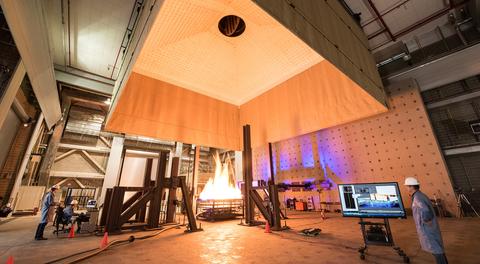Summary
The National Fire Research Laboratory (NFRL) is a leading global facility for large-scale experimental studies on fire behavior in multi-room structures, systems, and materials. It offers unparalleled capabilities for studying complex fire and structural load scenarios. The Operations and Safety project supports the NFRL Director, partially funds laboratory staff, and covers operations, maintenance, and safety expenses. The project also maintains the strategic, business, and operational plans that support NFRL research and a robust safety program specifically designed to address the unique challenges of large-scale fire and structural testing.
Description

Objective
To develop and maintain the research portfolio and standard operating procedures including standard test protocols, the safety program, and a robust business and operational model for large-scale fire-structural experiments.
Technical Idea
Currently there are few research facilities in the world that allow scientists and engineers to conduct research on the response of real-scale structural systems to a realistic fire and mechanical loading under controlled laboratory conditions. The NFRL allows structures, ranging in size from small components to large systems up to two stories in height and 2 bays × 3 bays in plan, to be tested under fully-developed building fires up to 20 MW using natural gas, liquid hydrocarbons, wood cribs, or actual building contents. Mechanical loading can be applied using configurable hydraulic actuators or fixed loads. The NFRL deploys innovative measurement techniques to (1) better characterize fire-structure interaction, (2) develop an experimental database on large-scale fires, (3) validate physics-based computational models to predict fire behavior and the fire resistance performance of structures, and (4) foster innovations in design and construction.
Research Plan
The NFRL research plan is shaped by strategic initiatives and topic‑specific road mapping exercises aimed at advancing fire safety research through large-scale experimentation, performance-based engineering, and modeling.
The Operations and Safety project ensures that NFRL remains at the forefront of safe and effective large-scale fire and structural testing. This includes:
- Developing safety best practices through data gathering, lessons learned, and benchmarking against other leading domestic and international laboratories.
- Maintaining critical infrastructure to support uninterrupted operations, including the NFRL Emissions Control Systems and other essential facilities.
- Developing and maintaining the NIST Fire Calorimetry Database for public access to data.
This project also funds the NFRL Director and partially supports laboratory staff, with the remainder of funding sourced through specific research projects. Importantly, the project supports NFRL’s operational strategy, which includes:
- Developing a staffing and business plan to ensure long-term stability.
- Forging strategic domestic and international partnerships to enable collaborative research.
By maintaining these critical functions, this project supports NFRL’s mission of advancing fire science and structural performance research on a global scale.
Major Accomplishments
- Completed and documented an assessment of domestic and international safety and operational best practices for testing of large-scale structures exposed to fire.
- Established a safety program, including training requirements for NFRL.

